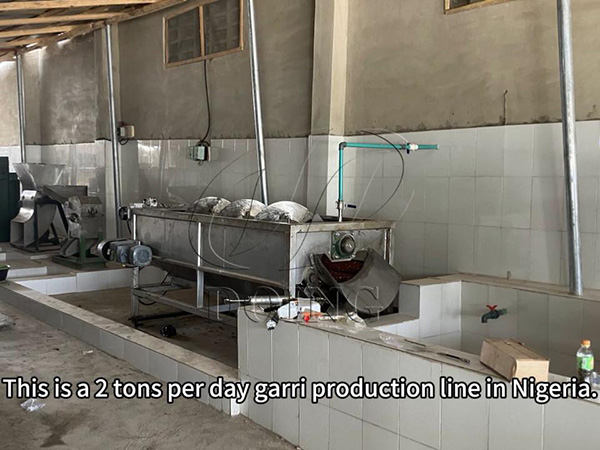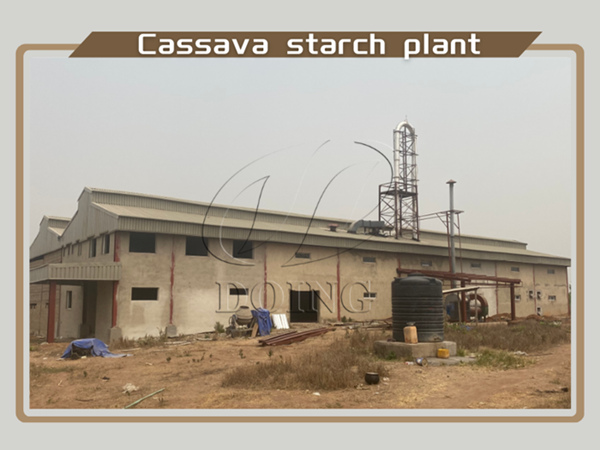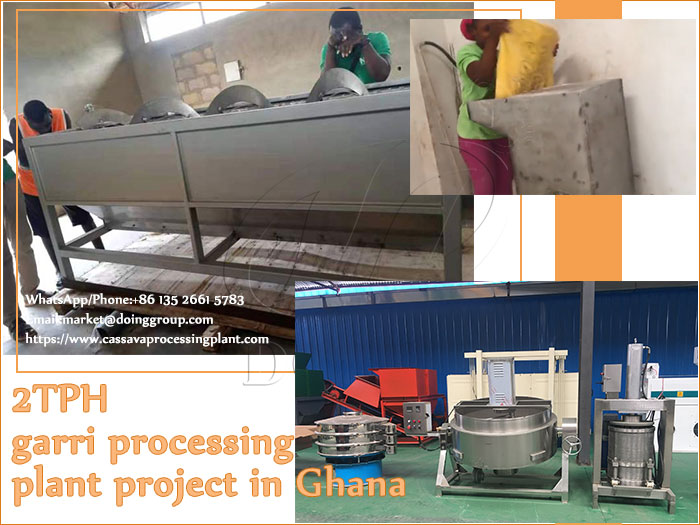
Complete Guide to Cassava Chips Production Process and Equipment
FAQ/ Chat online/ Leave a message/ March 26, 2025
Cassava chips have become a vital commodity in the global market, widely used in the production of animal feed and ethanol. These chips are primarily sourced from fresh cassava roots, which are abundant in Southeast Asian and African countries. With increasing demand, it is essential to understand the production process and the specialized equipment required to ensure high-quality cassava chips.
In this article, Henan Jinrui will provides you with a comprehensive guide, that will walk you through the entire cassava chips production process and highlight the advanced equipment that can significantly enhance efficiency and productivity.
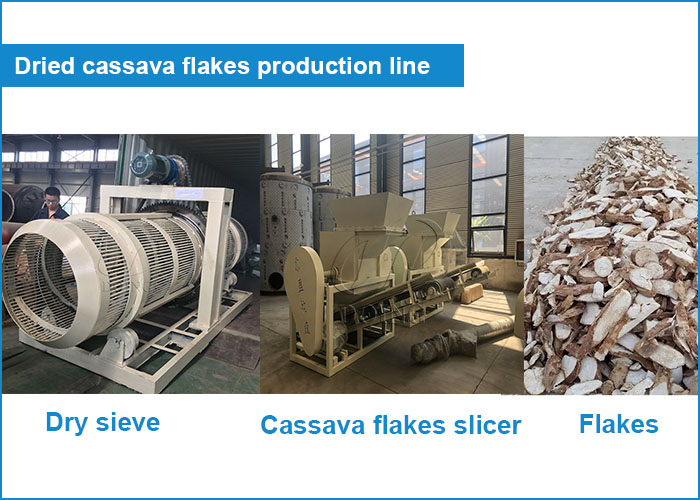 Cassava chips production process
Cassava chips production process
1. Cleaning and Washing Cassava Roots: The first step in production process of cassava chips is to thoroughly clean and wash the fresh cassava roots to remove surface mud and sand. This step is crucial for ensuring the quality of the final product, cassava chips. Proper cleaning not only removes impurities but also helps in reducing the risk of contamination during subsequent processing stages for cassava chips production.
2. Peeling Cassava Roots: After cleaning and washing, the cassava roots need to enter next process of cassava chips production, peeling to remove the outer brown skin and the inner thick cream layer. In the peeling process, regularly checking the water source is essential to ensure cassava chips is not contaminated. Peeling is a critical production process as it affects both the yield and quality of the cassava chips.
3. Cutting Cassava Roots into Wet Cassava Chips: In the cutting process for cassava chips production, using a high-speed rotating circular cutter blade, the peeled cassava roots are sliced into chips. The cutting process must be precise to ensure uniform cassava chips size, which is important for subsequent drying process of cassava chips production.
5.Drying Wet Cassava Chips into Dried Cassava Chips: The final production process involves drying the wet cassava chips into dried cassava chips. Drying can be done using specialized machines or natural sunlight, depending on the scale of cassava chips production and available resources. Proper drying ensures that the cassava chips have a long shelf life and are suitable for various applications.
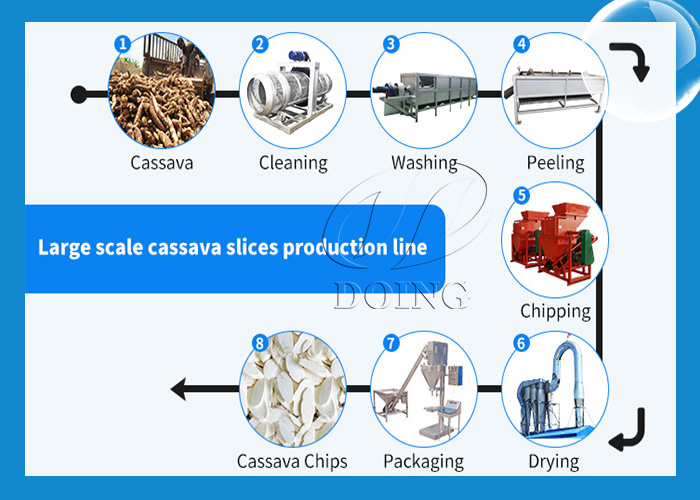 Cassava chips production line
Cassava chips production line
1. Cassava Cleaning and Washing Equipment: The cleaning process begins with a dry sieve that removes cassava surface dirt and sand. This is followed by a paddle washer that thoroughly cleans the cassava tubers with water. For those with less stringent cleaning requirements, a dry sieve alone can be used. Henan Jinrui's advanced cleaning equipment is designed to maximize efficiency while minimizing water usage, making them both cost-effective and environmentally friendly.
2. Cassava Peeling Equipment: For peeling process of cassava chips production, we highly recommend the new design sand roller peeling equipment supplied by Henan Jinrui Company. This innovative equipment removes both the first and second layers of the cassava roots, achieving 90% peeling rate while minimizing cassava loss. Our peeling machine is known for the durability and ease of operation, ensuring high quality and high yield in cassava chips production.
3. Cassava Chips Making Equipment: The cassava slicer is the equipment used for cassava chips making process. The equipment provided by Henan Jinrui, features a high-speed rotating circular cutter blade with a robust structure, ensuring a large production capacity, ranging from 5 to 10 tons per hour. Our cassava chips making equipment is designed for high efficiency and reliability, making it the ideal choice for both small-scale and large-scale cassava chips producers.
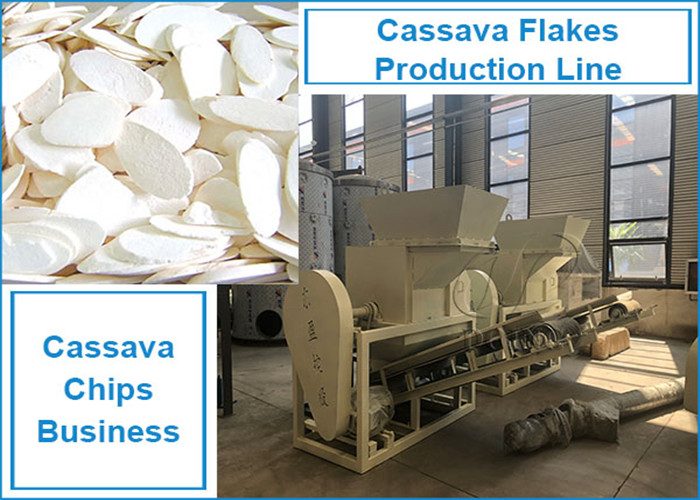 Cassava slicer
Cassava slicer
4. Cassava Chips Drying Equipment: Cabinet dryers, belt dryers, and drum dryers are common equipment used for cassava chips drying. However, considering the high energy consumption of mechanical dryers, many cassava chips investors prefer to dry chips using natural sunlight. But cassava chips drying equipment can significantly reduce drying time compared to traditional methods, also come with advanced temperature and humidity controls to ensure consistent drying results for cassava chips production.
Henan Jinrui is a professional manufacturer and supplier of cassava processing equipment, including cassava chips making machines, garri production machinery, cassava flour production lines, and cassava starch projects. We have many years of experience in cassava processing lines and can provide customized solutions based on specific needs.
In summary, there are multiple processes involved in cassava chips production, which require specialized equipment. By following the cassava chips production process and investing in high-quality equipment, manufacturers can ensure the production of high-quality cassava chips that meet consumer and market needs. If you would like to learn more about projects and machine investments, please feel free to contact us!
Leave A Message
- Do you want to buy machine?
- Yes, I want to buy machine
- No, I want to learn more in advance.
- What is your raw material?
- Cassava
- Potato
- Sweet potato
- Others
- 2. What is the final product you want to produce?
- Garri
- Cassava flour
- Cassava starch
- Cassava chips
- Attiekie
- Bammy
- Others
- 3.What is your capacity plan?
- Small scale garri machine
- 1ton per day
- 2tons per day
- 3tons per day
- 10tons per day
- 20tons per day
- Others
- 3.What is your capacity plan?
- Small scale
- 5tons per day
- 10tons per day
- 20tons per day
- 50tons per day
- 100tons per day
- Others
- 3.What is your capacity plan?
- Small scale
- 5tons per day
- 10tons per day
- 20tons per day
- 50tons per day
- 100tons per day
- 200tons per day
- 300tons per day
- Others
- 3.What is your capacity plan?
- Small scale
- Middle type
- Large scale
- What is your capacity plan?
- Small scale
- 5tons per day
- 10tons per day
- 20tons per day
- 50tons per day
- 100tons per day
- 200tons per day
- 300tons per day
- Others

